ACCS: Unanswered Questions (part of 2)
In short, the decision of the brigade commander on any type of tactical actions is a set of design, specific tasks to subordinate units, basic issues of interaction, control and comprehensive support. In other words: if the plan answers the question “how?”, Then the solution is the answer to the questions “how?”, “Who?” And “when?”.
Usually, after determining the intent, the brigade commander submits its graphic and textual part to the senior commander for approval. The statement of the plan (decision) is a matter of principle, for here it is decided whether the brigade commander’s plan was understood correctly by the senior commander and whether his plan was in line with the decision made by the army commander. So that the commander of the army (OK) could see in a non-automated mode how the brigade commander decided to carry out the combat mission assigned to him, he needed to either call the commander with the map of the plan to himself, or himself to arrive at the command post of his subordinate.
Not dazzle, by the way. The removal of an army KP from a KP brigade in a defensive operation can be both 40 and 100 km. A combined brigade in the army (OK) - from three to five or six. Therefore, the commanders of the formations usually reported their plans to the commander by telephone. And the graphics? But treated somehow. Since transferring the graphic part by “dictating” over the phone is to doom yourself to a bunch of inconsistencies and inconsistencies.
Logically, automating the process of transferring graphic information from a lower-level PU to a higher-level one should ensure automatic reproduction on the screen of the senior chief of the graphic image of the subordinate's solution.
I remind you that the Acacia and Constellation systems still cannot reproduce graphic information of each other.
Nevertheless, let us assume that there is a terminal in the army headquarters, with software loaded on it from the ESU TZ. The commander during the report of the brigade commander had the opportunity to see the plan and approved it.
Immediately after this, the decision-making process begins at the brigade headquarters. With sole determination by the commander of combat missions. But they are determined on the basis of tactical calculations. The most important of which, at this stage, is the calculation of the ratio of forces and means and the distribution of forces and means. In accordance with modern requirements, such calculations are not carried out by simply calculating the quantity tanks, guns and TCP of their troops and the enemy, and by comparing the combat potentials of combined arms units, taking into account their staffing, security and reinforcement with the arms of the armed forces and special forces, which are introduced into the calculation formulas with the corresponding coefficients. It is simply unrealistic to make such a comparison “manually” (within the time allotted to the brigade commander to work out a solution by the current standards). After all, the results of such calculations should not be the notorious “three to one,” but the determination of the probability of the occurrence of such an event as the unit’s fulfillment of its combat mission. With a parallel calculation of the possible losses of their troops and the enemy, the speed of advancement and the depth of the enemy’s penetration into our defense, etc.! And all this taking into account time parameters, such as, for example, the time for engineering equipment of the defense area by our troops, etc.
Does the hardware of the ESU TZ allow such calculations to be carried out within the established time limits? The exact answer to this question does not exist yet. Because in the software available in the ESU TZ, the methodology of such calculations, as well as the calculated data necessary for their implementation (combat potentials and coefficients), are simply not available.
About Microsoft and Excel has already been said.
After the commander has determined the tasks for the combined-arms units, the commander, together with the deputies and chiefs of the arms and services, specifies the tasks of the branches of the arms and special forces. Approximately in the same way as was described in the “Design” section.
It is quite problematic to do it automatically in the ESU TZ system (which, as is known, consists of several subsystems - the commander and headquarters, reconnaissance, artillery, air defense, etc.). And that's why.
Different subsystems were made by different manufacturers for the ESU TZ. Not only members of the concern "Constellation". But about them - later.
Concern "Constellation" is a set of research and production enterprises and institutions that specialize mainly in the development and production ... attention, drum roll (!) ... .. MEANS OF COMMUNICATION.
So here. The chief of communications 5 ombsbr in the course of the research KShU in Alabino, was forced to receive tasks from the chief of staff of the brigade not in an automated mode, but by personal communication, due to the fact that ...
(quoted from the exercise report documents):
"... software was loaded on the automated workplace of the brigade chief of communications, which does not fit in with the software of the subsystem of the commander and staff"
End of quote.
Shoemaker without shoes?
Approximately the same situation with the subsystems of intelligence, air defense and others.
You see, my deep conviction is that the concept of “integrating a subsystem into a common ACCS system” should not be limited only to installing the air defense chief of a single computer brigade from the commander’s and headquarters subsystem at the command post of the Barnaul system. Information from which must be manually transferred to the automated workplace of the Barnaul complex.
Integration is when the entire military situation displayed by the commander on an electronic map in his subsystem is automatically displayed directly in the information display devices of other subsystems, and not only in the remote control workstations of the subsystem installed on the PU of the heads of arms and services. And vice versa: information, for example, on the air situation, formed in the air defense subsystem (the Barnaul complex) should (if the commander so desires) be displayed “on top” of the general tactical situation, directly in its headquarters vehicle. And without any "mediation" of officers of both control subsystems.
But suppose that the above problems in the automatic control system of our "virtual brigade" are absent.
What is the “end product” of the work of the brigade’s management at the stage of developing a solution?
Battle documents!
It is documents, not electronic files, because the analytical and synthetic activities of the commander and staff at this stage “crystallize” into their legal form.
In other words, everything that has been done by the commander and headquarters since the start of battle preparation should be presented not in mathematical abstractions, but in the publicly available "paper" forms. Which, in the event of a successful outcome of the battle, will be studied by our descendants-historians in military archives, and if unsuccessful, they will also be studied and hemmed by contemporaries from the relevant authorities in a plump volume called “criminal case”.
The most important of these documents are:
1. Work card of the brigade commander (decision map approved by the senior commander).
2. Textual part (legend) of the decision, or an explanatory note to the decision.
3. Combat orders to the commanders of all divisions of the brigade, as well as orders on all types of support (also to all divisions of the brigade).
We already know that it is possible to send an e-map file of the decision of the brigade commander to the control center of the senior commander. Just open and see - it does not work yet. But if such a function is implemented, then a function of the so-called should be added to it without fail. "Electronic signature". After which such a file should be impossible to change in principle. The same should be with the approved decision files of the brigade commanders. Kombrig accepted, read, looked, approved - printed out.
And in the safe. For the prosecutor. Or a historian. At this point - how lucky.
How does the ESU TZ complex deal with the printing of the most important combat graphic documents, that is, maps?
Not yet.
Although, there is a device for printing maps in the kit, but the decision of the brigade commander on defense during the command and control command in Alabino failed to print. For technical reasons. I sincerely hope - disposable.
Nevertheless, suppose that all these annoying technical problems have been successfully solved. And again, suppose that our “politically correct” adversary has the ability and desire to in some way influence the brigade located in the area of concentration during the development of a decision. And one of such effects of the enemy irrevocably put out of action, say, several automated workplaces of the command post of the chief of artillery.
Suppose that even all the officials working at this control point are safe and sound. What to do with lost information?
This question has long been answered in large civil companies, such as banks and other "Gazprom". Backup on corporate data servers of hard drives of all computers running on the network. Well, the hard drive failed. - well, it happens! System administrators find its last saved image on the server and restore the data of the “lost” machine to the hard drives of the new one. The loss of data is only in the period of time that has elapsed between the last backup and the exit of the machine.
But in the ESU TZ - completely serverless architecture of the local network. That is, there is simply nothing to compensate for the loss of data in the destroyed machine. There is no backup to the server, due to the lack thereof. The information of the destroyed artillery chief of the artillery can not be recovered!
For those who do not know, let me remind you - this system is intended for use not in warm office conditions, but in war, where the main goal is not to count dividends, but to destroy the enemy! Which, in turn, also has the main purpose of the destruction of us. And in achieving this goal, he will first of all seek to destroy our control system.
Or someone else needs to prove it?
5. Task setting and battle planning.
The formulation of the combat missions defined in the decision of the commander of the brigade to the subunits in the case of the use of an automated command and control system should be done in the same way as the formulation of the combat mission of the brigade. That is, the battalion commander must receive in electronic form the text of the combat order, instructions on the types of support and a file for applying it to his electronic card with the display:
known at the time of setting the task data about the enemy;
in fact, the tasks of the battalion in full;
the positions and tasks of units performing tasks in the interests of the battalion (for example, engineering and RCB units ensuring its advancement to the defense area);
tasks of supporting battalion units;
the tasks of other units operating in the battalion's zone (area of responsibility) (for example, PTRez and POR brigade), demarcation lines with neighbors and their tasks (to maintain stable interaction with them).
Having received this data, the battalion commander clarifies the task, assesses the situation, makes a decision and reports it to the brigade commander. Naturally, electronic files by means of communication. After the approval of his decision by the brigade commander, he sets the task for the company commanders. On the lower "steps" the battle organization cycle is repeated up to and including the squad leader.
At the same time, at the brigade headquarters, the decisions of the brigade commander should be superimposed on the electronic map of the decisions received from subordinates, thereby completing the planning cycle. The fact is that, in accordance with the governing documents, planning is a detailed development of the sequence, timing and methods of actions involved in the combat units, forces and assets. In the course of planning, the decisions of subordinate commanders are put two steps down on the work card of the brigade commander. In the brigade - to the company (battery), inclusive.
When applying the automatic control system, the problem will be in the so-called. "Slaughter" topobasovy Overlaying the decisions of subordinates to the kombrig card, even by one step, makes the decision so “overloaded” that under the mass of tactical signs you can no longer see the topographic bases on which they are applied. There is a solution - the use of automatic reduction of tactical signs with a simultaneous transition to a larger-scale display of topobase
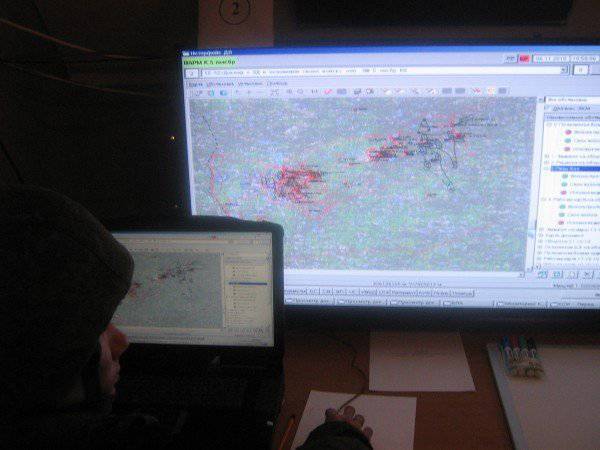
Fig. 11. The decision of the commander of 5 ombsbr for defense, displayed using hardware and software of the ESU TZ "Constellation".
That's just in the graphical editor used in the ESU TZ can not do this. Tactical marks will increase in size in proportion to the scale of the map display. And still “hammer” the topobas.
Therefore, during the command-and-control school in Alabino, the decision of the subordinate commanders on the map of the commander decided not to display at all (Fig. 11). On the right side of the screen, the firing positions of the brigade artillery group (Brag) are clearly visible. The firing positions of the divisions are displayed by areas, not “battery-wise”.
North of the area of the OP of the Brag can be seen the location of the battalion "on-battery". However, do not flatter yourself. This is the area of the 1 launch position of the 132 battalion of the anti-aircraft missile brigade - that is, the means of the army commander (OK). On the map of the brigade commander, this division was struck as early as the time the brigade received the combat mission.
And this is what is displayed on the screen of the AWS of the battalion commander (Fig. 12):
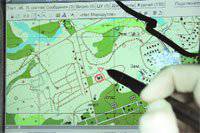
Fig. 12. Screen view of the battalion commander
Let me explain.
This section of the map reproduces the Alabinsky polygon. It, in fact, was carried out KSHU. The red circle in the center of the map is the point of standing (location). Logically, the entire map around it should be in blue red and black tactical signs. But we see only a red circle and a triangle.
But was the battalion commander’s combat mission actually set? After all, only the file with the graphic task of the battalion commander should consist of dozens of tactical signs? And did the decisions of the commanders of the divisions with the use of the ESU TZ complex worked out during this exercise?
Why do we see an empty card at the battalion commander?
And was there actually a boy?
And, by the way, about the stability of the system to the effects of the enemy. In the event of failure of the AWP of the commander of any level, it will be impossible, as we already know, to recover the lost information in the ESU TK system. So, if during the battle the bullet hits the armored position of the battalion commander, then it will also be impossible to switch to “manual control” using an ordinary paper card or a printed copy of your electronic card file. A device for printing maps (large-format plotter) is only in the management team. In a single copy.
At the same time, devices for printing (not only maps, but in general any documents, even A4 format) at the battalion level and below are absent as a class.
6. Management in the course of combat.
Once again I will quote the head of the KSHU with the 5 omsbrr colonel M.Yu.Teplinsky:
“In order to switch to an automated control method, we need to know what we really need. At the moment we have an understanding of what we need when planning.
The first and most important thing is the automated exchange of information at workplaces, which will allow us not to pull the chiefs of the arms of services and services from their seats. From your workplace. To ensure their work directly at their command and control points and transfer information to each other and the commander by means of communication.
The second. Automatically bring the "general", that is, the combined arms situation. It is passed on to everyone and everyone imposes its own proposals on it, its decision.
But we do not have a common understanding of what needs to be done and how to carry out automated control of troops during a battle. During the dynamics that will go. When the situation changes - who will type some messages on the keys with shaking hands?
This will not happen! Unfortunately."
It should be clarified here that due to the impossibility of simultaneous work of several officials on one electronic card in the ECU TZ system, the exchange of graphic information (as it is accumulated) is carried out by transmitting the files of the situation embedded in a special program (analog of e-mail) messages. Which are sent to the selected senders addresses (circular, or selectively).
It should be noted that, despite the lack of simultaneous teamwork on one map, for example, the commanders of battalions and the brigade commander, the latter can receive data on the position of objects with GLONASS positioning systems on the screen of their AWP. That is, against the background of a topographic base, you can see in real time the APCs of subordinate units moving across the battlefield and precisely determine their coordinates. In principle, commanders of all levels can see the position, direction of movement and determine the coordinates of any such object - up to and including the soldier. And this is important!
However, the data on the coordinates of the target detected by the aircraft (helicopter) or the UAV operator are still not automatically able to enter the system and require preliminary processing "manually". Nevertheless, even taking into account the “manual processing” of such data, their transfer rate to the means of destruction has increased significantly.
And yet, according to Colonel M.Yu. Teplinsky, the “main supplier” of data on the position of the enemy, so far, only organs and means of radio, radio engineering and military intelligence, which have appropriate complexes for detection and identification ( identification) of enemy objects and determine their coordinates.
Let us try to present the entire chain of appearance, transmission and realization of information in the control system on any one example. So we will understand the meaning of information tasks, processes and operations.
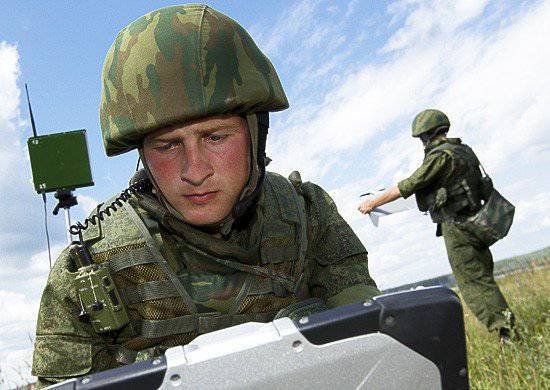
Let us take the most fashionable source of information now - the unmanned aerial vehicle (UAV). We will not go into its flight data (type and engine power, unit load on the wing, maximum range and flight altitude, payload, duration of stay in the air, maneuverability, etc.). Naturally, "the better, the better." However, all these indicators are not so important for us from the point of view of the passage of information.
We will also leave aside the issue of controlling the device itself in flight. For us, so far it does not matter either - whether the UAV flies “independently” (that is, according to a predetermined program), or is controlled by the operator, and also sits on the runway or on a parachute.
Just suppose that we have a certain reconnaissance device with certain "medium" LTDs capable of flying, videotaping and photographing the "underlying surface". As well as equipped with communication facilities that allow transmitting the received information to the take-off point (flight control center).
The main thing is that he would do it!
I will make a reservation right away: it is possible that some specific flight terms by me will not be used entirely correctly in the future (your humble servant is still not an aviator), but I repeat once again: we are not interested in aerodynamics now, but in the information component of the preparation and direct flight process.
So fly?
Stop!!!
First: in the army, everything is done on the orders (team)! Including flights of all and every kind of aircraft.
Secondly: Where to actually fly?
Naturally, the territory occupied by the enemy, where else?
But the capabilities of the apparatus are not limitless, and the time it takes to fly around the entire detailed brigade reconnaissance zone is more than “instantly”. And in defense, by the way, this zone (i.e., the front of defense multiplied by the maximum range of fire of the most long-range means + 1 / 3 of the front of the defense zone to the neighbors) can be 20 on 35-40 km.
Just!
In order to completely “cover” this area with photographs of 400 surface on 500 meters (200 000 sq. M) taken from the height of flight in 200 m, you need to make about 4000 (four thousand!) Pictures. To do this, the UAV must fly in a straight line (not counting bends) about 1600 km.
With an average speed of 100 km / h, the duration of the flight throughout the zone will be (without overlapping the image area) 16 hours.
Isn't it a bit too much for the pace of modern all-arms combat?
For your information:
The speed, range and duration of the flight of domestic UAVs in the Russian Federation:

Therefore, when preparing for defense, there is such a thing as the “direction of concentration of the main efforts” (NOCS).
Contrary to popular belief, the “direction” in this case is by no means a “thin red line”, but an areal figure! Sometimes a rather bizarre geometric shape. Its boundaries are determined by the senior commander of the brigade at the disposal of the brigade (order). Within these limits, when making a decision, the commander concentrates the bulk of his forces and assets, and the methods of their influence on the enemy. And the chief of the brigade’s intelligence is the main effort.
subordinate forces and means of intelligence. As a rule, this zone can range from 1 / 4 to 1 / 3 to the entire area of detailed brigade reconnaissance.
But how does the commander of the reconnaissance body (the commander of the reconnaissance platoon of the reconnaissance company of the reconnaissance battalion of the brigade) learn about this? In other words: how information about the boundaries of the direction of concentration of the main efforts of the brigade will reach the performer?
And here we go into the field of solving information problems.
The transmission of this information relates to the information task number 3, “Bringing in combat missions”, which includes the following information processes:

The simplest (and most visual) way of setting tasks is to transfer an electronic graphical file from the control point to the control object (in this case, to the commander of the intelligence agency) an image of the intended flight area inscribed in the same geometric figure denoting the NOCS:
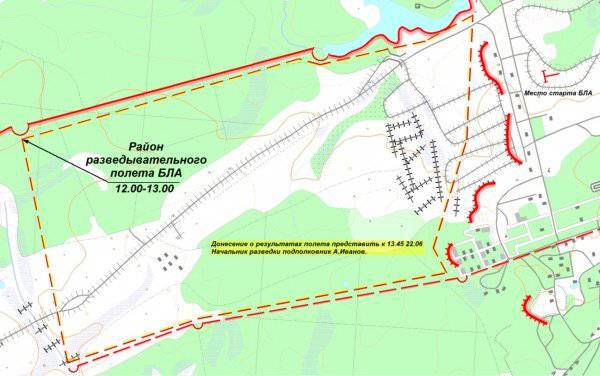
And where does all this come from?
To create such a file, the brigade intelligence chief (if he assigns the task to the intelligence commander directly, bypassing his immediate superiors) in his intelligence subsystem must:
1. Receive from the chief of staff instructions on the organization of reconnaissance, and from the brigade commander - relevant graphic information (subsystem of the commander and staff) on the outline of the demarcation lines, area (direction) of the JMA and the position of its troops on the 1 scale: 100 000. And this is the execution of 1.2 information processes “Collection of situation data” and 1.7 “Display of situation data” during the implementation of the information task number 1 “Continuous work with situation data”.
2. Bring the obtained graphic information to the base scale of your work map (1: 50 000) (execution of the 1.3 “Environment data processing” information process and display it on the screen of your workstation).
3. Estimate the area of the NOCS and the position of its troops, including the location of the UAV (1.4 information process. Studying the situation data of the same information task)
4. Make a decision on the organization of intelligence (accomplishment of the second information task “Developing a Solution” in full), including determining the procedure and terms for the use of UAVs (and not just one, but all those in the brigade).
5. Display on top of the situation received from the commander, his decision on the organization of intelligence and approve it from the National Brigade. An element of this decision will be the area and time of flight of our particular UAV, which is shown in the figure with a red dotted line with yellow trimming, as well as the order and timing of the report of the results obtained. (1.7 information display “Displaying Environment Data”).
6. To transfer the developed information to performers and ...
7. ... receive from them, first, the confirmation with confirmation, and then - the decisions of subordinates for the use of UAVs (flight tasks) and approve them, that is, perform the two above-mentioned information process information task number 3 "Bringing combat missions".
And what does the commander of an intelligence agency get after receiving a UAV task?
The procedure and, accordingly, the flow of information processes he has almost the same.
Displays. Clarifies. Evaluates the situation. Makes a decision. Displays the decision (flight task) on the electronic map of your automated workplace. Sends to intelligence chief for approval. Gets an approved version.
Something like this:
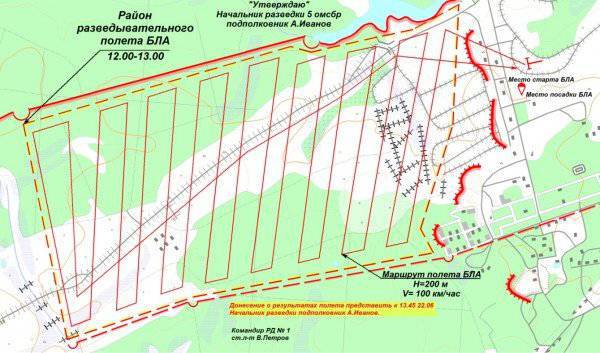
Flew?
But Indian home guys!
In the ESU TZ is not so simple. If the chief of intelligence with his only AWP enters simultaneously into two subsystems (commander and headquarters and intelligence control), then the commander of the reconnaissance patrol, which is included in the only subsystem (intelligence control), must have at least two of his automated sites:
This is an EC-1856 mounted on an armored vehicle:
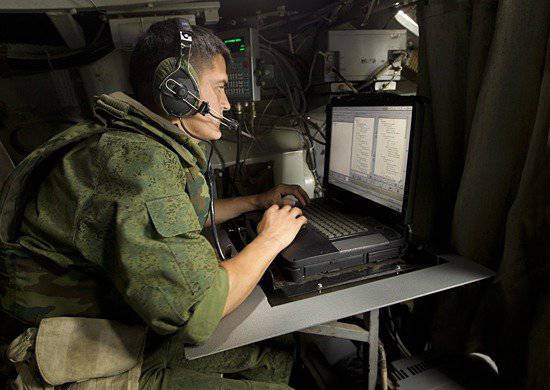
This device works on OS MSVS and the task to use BLA will come to it
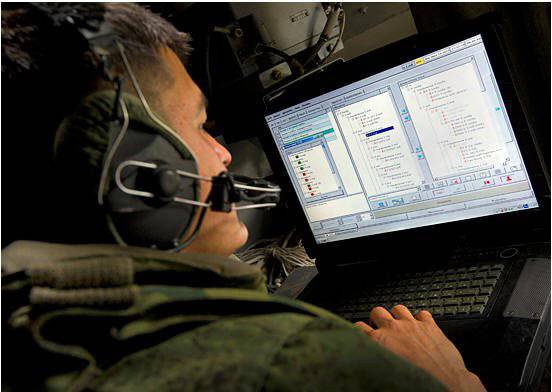
… .And also a laptop from Panasonic, which is used to compile a flight task and control a UAV in flight. The operating system is the notorious “Windows XP” (TM):
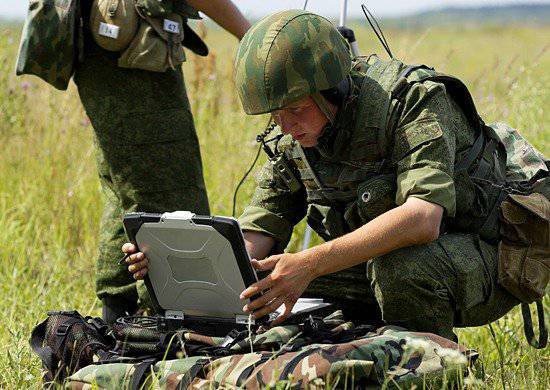
His view from the other side in the photo below.
As you have probably already guessed, the transfer of a graphical image of the flight area from one machine to another is not performed automatically, but by the patient handles of “V.S. Petrov, Art.”, The commander of the intelligence agency.
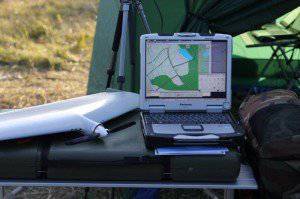
As well as the reverse transfer of the flight task from “Panasonic” to the EU-1866. Do you think such work greatly accelerates the process of preparing the flight?
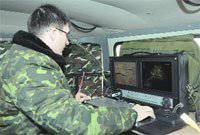
True, there is another version of the organization of intelligence using the UAV, more precisely, a tactical method of rubbing glasses to the big authorities, which was brilliantly demonstrated by the UAV creators in one of the exercises with the 5 ombsbr (pictured left). This is the deployment of the UAV flight control center (and the corresponding means to support it) directly in the brigade commander’s staff vehicle. That is - in the holy of holies of the command post - in the center of battle control. At the same time, the information necessary for the formation of the flight task is delivered personally by the brigade commander to the UAV operator. With the help of poke a pointer, or just a finger on the screen. And the working materials of the shooting at such a “joint” deployment of command and control equipment are immediately reported (shown) to the commander.
Of course - from the screen of the machine with which the flight control takes place.
This was probably done so that the enemy would not “bother” and, as a result of its radio and radio intelligence, would immediately crash the command and control point of the brigade to the UAV command and control center.
- http://dragon-first-ru.livejournal.com/
- ACCS: Unanswered Questions (part of 1)
ACCS: Unanswered Questions (part of 2)
ACCS: Unanswered Questions (last part of 3)
Information